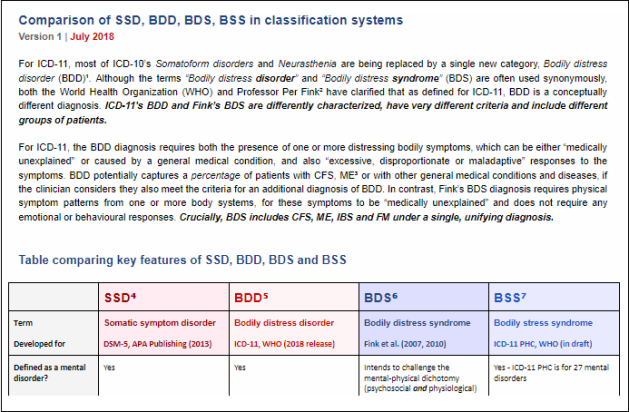Comparison of SSD, BDD, BDS, BSS in classification systems
July 21, 2018
Post #338 Shortlink: https://wp.me/pKrrB-4ni
The World Health Organization (WHO) released the next edition of the International Classification of Diseases (ICD-11) on June 18.
WHO news release.
ICD-11 for Mortality and Morbidity Statistics (ICD-11 MMS) version 2018 is an “advance preview” that will allow countries to plan for implementation, prepare translations and begin training health professionals.
No countries will be ready to transition from ICD-10 to ICD-11 for several years. The new edition is scheduled to be presented at the World Health Assembly (WHA) in May 2019 for adoption by Member States, but WHA endorsement won’t come into effect until January 1, 2022.
After that date, Member States can begin using the new edition for data reporting but there is no mandatory implementation date and for a period of time, the WHO will be collecting data recorded using both ICD-10 and the new ICD-11 code sets.
I’ll be posting key links and information on the release of this “advance preview” in future posts. In the meantime, here’s the current schedule:

Bodily distress disorder
For the main edition of ICD-11, most of ICD-10’s Somatoform disorders and Neurasthenia have been replaced with a single new diagnostic category called Bodily distress disorder [1].
The Bodily distress disorder term was added to the ICD-11 drafting platform in early 2012 and has been the only disorder construct under consideration for the main edition of ICD-11 [2][3].
SSD? BDD? BDS? BSS?
We are still seeing a good deal of confusion between ICD-11’s defining of Bodily distress disorder (BDD) and Per Fink’s Bodily distress syndrome (BDS) disorder construct [4][5].
To assist stakeholders in navigating the complexities of nomenclature and classification, Dx Revision Watch and Mary Dimmock have prepared a document comparing the key features of:
DSM-5’s Somatic symptom disorder (SSD)
ICD-11’s Bodily distress disorder (BDD)
Fink et al. (2010) Bodily distress syndrome (BSD)
Bodily stress syndrome (BSS), as proposed for the ICD-11 PHC
You can download a copy of the comparison table and notes, here:
Comparison of SSD, BDD, BDS, BSS in classification systems
Version 1 | July 2018
Click to access comparison-of-ssd-bdd-bds-bss-in-classification-systems-v1.pdf

References:
1 Creed F, Gureje O. Emerging themes in the revision of the classification of somatoform disorders. Int Rev Psychiatry. 2012 Dec;24(6):556-67. doi: 10.3109/09540261.2012.741063. [PMID: 23244611]
2 Gureje O, Reed GM. Bodily distress disorder in ICD-11: problems and prospects. World Psychiatry. 2016 Oct;15(3):291-292. doi: 10.1002/wps.20353. [PMID: 27717252]
3 ICD-11 for Mortality and Morbidity Statistics (ICD-11 MMS) 2018 Release, Version for preparing implementation. Accessed July 20, 2018 https://icd.who.int/browse11/l-m/en#/http%3a%2f%2fid.who.int%2ficd%2fentity%2f767044268
4 Fink P, Schröder A. One single diagnosis, bodily distress syndrome, succeeded to capture 10 diagnostic categories of functional somatic syndromes and somatoform disorders. J Psychosom Res. 2010 May;68(5):415-26. [PMID: 20403500]
5 Syndromes of bodily distress or functional somatic syndromes – Where are we heading. Lecture on the occasion of receiving the Alison Creed award 2017, Fink, Per. Journal of Psychosomatic Research, Volume 97, 127 – 130
https://www.jpsychores.com/article/S0022-3999(17)30445-2/fulltext
Lecture slides: http://www.eapm2017.com/images/site/abstracts/PLENARY_Prof_FINK.pdf
